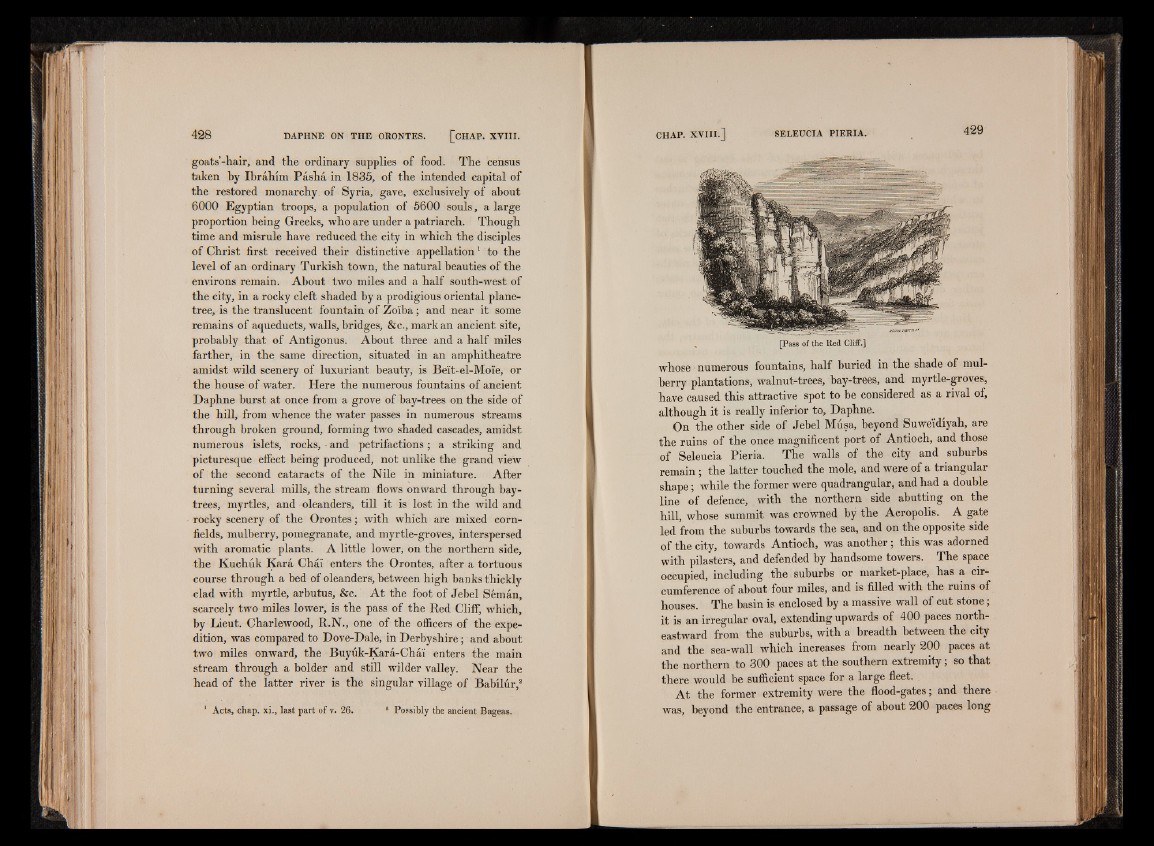
goats’-hair, and the ordinary supplies of food. The census
taken by Ibrahim Pasha in 1835, of the intended capital of
the restored monarchy, of Syria, gave, exclusively of about
6000 Egyptian troops, a population of 5600 souls, a large
proportion being Greeks, who are under a patriarch. Though
time and misrule have reduced the city in which the disciples
of Christ first received their distinctive appellation1 to the
level of an ordinary Turkish town, the natural beauties of the
environs remain. About two miles and a half south-west of
the city, in a rocky cleft shaded by a prodigious oriental plane-
tree, is the translucent fountain of Zolba; and near it some
remains of aqueducts, walls, bridges, &c., mark an ancient site,
probably that of Antigonus. About three and a half miles
farther, in the same direction, situated in an amphitheatre
amidst wild scenery of luxuriant beauty, is Beit-el-Moi'e, or
the house of water. Here the numerous fountains of ancient
Daphne burst at once from a grove of bay-trees on the side of
the hill, from whence the water passes in numerous streams
through broken ground, forming two shaded cascades, amidst
numerous islets, rocks, ■ and petrifactions; a striking and
picturesque eifect being produced, not unlike the grand view
of the second cataracts of the Nile in miniature. After
turning several mills, the stream flows onward through bay-
trees, myrtles, and oleanders, till it is lost in the wild and
rocky scenery of the Orontes; with which are mixed cornfields,
mulberry, pomegranate, and myrtle-groves, interspersed
with aromatic plants. A little lower, on the northern side,
the Kuchuk Kara Chai enters the Orontes, after a tortuous
course through a bed of oleanders, between high banks thickly
clad with myrtle, arbutus, &c. At the foot of Jebel Seman,
scarcely two miles lower, is the pass of the Red Cliff, which,
by Lieut. Charlewood, R.N., one of the officers of the expedition,
was compared to Dove-Dale, in Derbyshire; and about
two miles onward, the Buyuk-Kara-Chai enters the main
stream through a bolder and still wilder valley. Near the
head of the latter river is the singular village of Babilur,2
1 Acts, chap. xi., last part of v. 26. s Possibly the ancient Bageas.
[Pass of the Red Cliff.]
whose numerous fountains, half buried in the shade of mul-
berry plantations, walnut-trees, bay-trees, and myrtle-groves,
have caused this attractive spot to be considered as a rival of,
although it is really inferior to, Daphne.
On the other side of Jebel Musa, beyond Suweidiyah, are
the ruins of the once magnificent port of Antioch, and those
of Seleucia Pieria. The walls of the city and suburbs
remain; the latter touched the mole, and were of a triangular
shape; while the former were quadrangular, and had a double
line of defence, with the northern side abutting on the
hill, whose summit was crowned by the Acropolis. A gate
led from the suburbs towards the sea, and on the opposite side
of the city, towards Antioch, was another; this was adorned
with pilasters, and defended by handsome towers. The space
occupied, including the suburbs or market-place, has a circumference
of about four miles, and is filled with the ruins of
houses. The basin is enclosed by a massive wall of cut stone;
it is an irregular oval, extending upwards of 400 paces northeastward
from the suburbs, with a breadth between the city
and the sea-wall which increases from nearly 200 paces at
the northern to 300 paces at the southern extremity; so that
there would be sufficient space for a large fleet.
At the former extremity were the flood-gates; and there
was, beyond the entrance, a passage of about 200 paces long